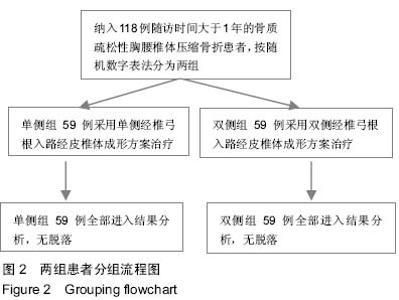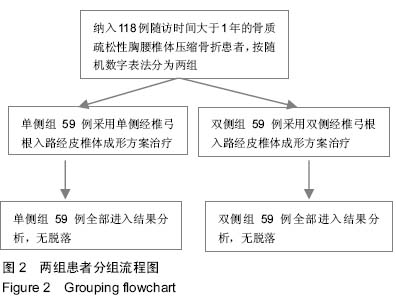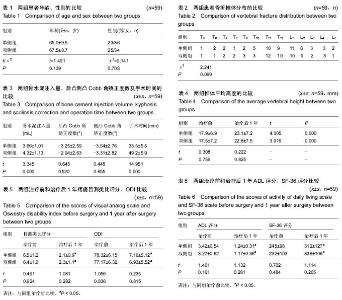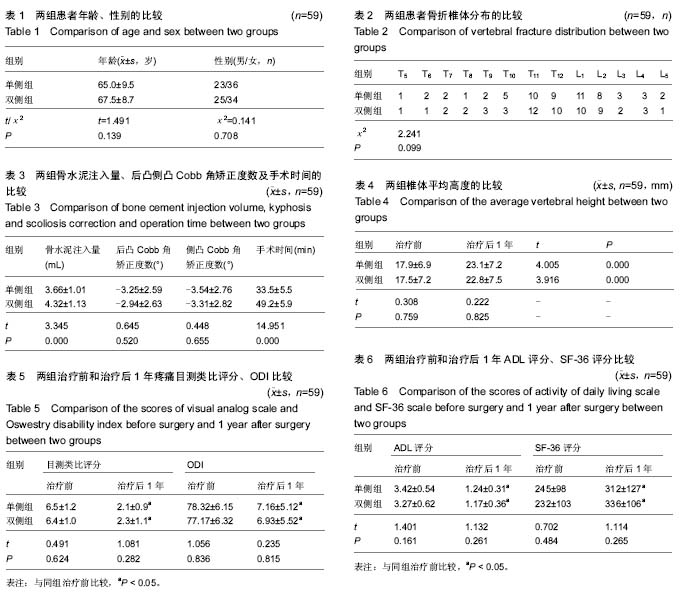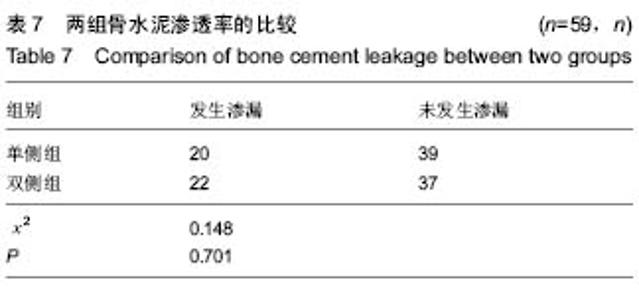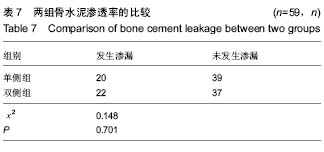| [1] 贾小林,杨阜滨,谭祖键,等. PVP与PKP治疗骨质疏松性骨折止痛效果分析[J].中国骨质疏松杂志,2009,15(1):53-55.
[2] Luo J,Daines L,Charalambous A,et al. Vertebroplasty:only small cement volumes are required to normalize stress distributions on the vertebral bodies. Spine(Phila Pa 1976). 2009;34:2865-2873.
[3] 高粱斌,陈嘉裕,张亮,等.经皮椎体成形术中骨水泥注射量与疗效和并发症的相关性研究[J].中华创伤骨科杂志,2009,11(6):532-536.
[4] Jin YJ,Yoon SH,Park KW,et al.The volumetric Analysis of cement In vertebroplasty:relationship with clinical outcome and complications. Spine(Phila Pa 1976). 2011;36:E761-772.
[5] 朱爱祥,朱裕成,郑红兵,等.单侧与双侧经皮后凸成形术治疗骨质疏松性椎体骨折疗效比较[J].临床骨科杂志,2010,13(2):132-134.
[6] 李健,吴溢峰,杨波,等.双侧双平面与单侧经椎弓根椎体成形术疗效比较[J].中国矫形外科杂志,2011,19(2):91-95.
[7] Graham J,Ahn C,Hai N,et al.Effect of bone Density on vertebral strength and stiffness after percutaneous vertebroplasty. Spine (Phila Pa 1976). 2007;32:E505-511.
[8] 孟纯阳,王国栋,王叶新,等.经皮椎体成形术治疗老年骨质疏松性胸腰椎压缩骨折[J]. 实用骨科杂志,2011,17(1):60-62.
[9] 方心俞,林建华,叶君健,等.椎体成形术治疗骨质疏松性椎体压缩骨折的临床相关研究[J]. 中国骨与关节损伤杂志,2013,28(1): 22-24.
[10] 周志刚,李志忠,焦根龙,等.后路手术治疗退变性腰椎侧弯疗效观察[J].山东医药,2011,51(10):45-46.
[11] 王冰,吕国华.前路小切口人工髓核置换术治疗退变性腰椎间盘疾患的远期效果[J]. 中国脊柱脊髓杂志,2011,21(12):996-1000.
[12] 何卫斌,冉学军.经皮球囊扩张椎体后凸成形术治疗老年骨质疏松性胸、腰椎压缩性骨折61例疗效分析[J].重庆医学,2012, 41(15):1499-1500.
[13] 邹文,朱美忠,胡天志,等.电磁导航经皮椎体成形术治疗胸、腰椎骨质疏松性压缩性骨折21例的疗效分析[J].重庆医学,2012, 41(15):1484-1485,1488.
[14] 尚鑫.舒适护理对老年腰椎压缩性骨折术后患者疼痛的影响[J].护士进修杂志,2013,28(2):180-182.
[15] 朱新炜,高浩源,邱思强,等.PVP治疗老年骨质疏松性椎体非压缩性骨折的疗效观察[J].中国矫形外科杂志,2013,21(4):342-345.
[16] 庾伟中.经皮球囊扩张椎体成形术治疗胸腰椎骨质疏松性压缩性骨折67例[J].中国老年学杂志,2012,32(10):2161-2162.
[17] 庞彬,钟传礼,翁玄,等.单侧经皮球囊扩张椎体后凸成形术治疗26例胸、腰椎压缩性骨折的近期疗效观察[J].重庆医学,2012, 41(15):1492-1493,1495.
[18] 邹戟,赵红卫,陈卫东,等.经皮椎体成形术与经皮椎体后凸成形术治疗骨质疏松脊柱压缩性骨折的临床对比分析[J].中国老年学杂志,2012,32(24):5581-5582.
[19] 张德宏,王兴盛.Wiltse椎旁入路治疗胸腰段压缩性骨折[J].临床骨科杂志,2012,15(3):245-247.
[20] 黄宇,林晋,陈宣维,等.经皮椎体成形术治疗骨质疏松性压缩性骨折的有限元力学分析[J].中国老年学杂志,2014,34(22): 6277-6279.
[21] 李振,齐建军,董明岩,等.经伤椎椎弓根自体骨植骨联合螺钉内固定术治疗腰椎压缩性骨折78例效果观察[J].山东医药,2012, 52(23):17-18.
[22] 李坚,陈其昕,张金喜,等.经皮椎体成形骨水泥注入治疗老年脊椎骨质疏松压缩性骨折的疗效[J].中国老年学杂志,2014,34(15): 4376-4378.
[23] 唐炎铭,雪原,丁怀荣,等.抑郁症与绝经后骨质疏松患者胸椎压缩性骨折的相关性分析[J].山东医药,2014,54(6):90-91.
[24] 张长春,朱坤,周建生,等.经皮椎体成形术和经皮椎体后凸成形术治疗老年女性胸腰椎移行处单椎体骨质疏松性压缩性骨折对邻接椎体骨密度的影响[J].中国老年学杂志,2014,34(20): 5741-5743.
[25] 陈华丽,朱雪美,颜晶晶,等.椎体后凸成形术治疗老年性骨质疏松性脊柱压缩性骨折的护理体会[J].护士进修杂志,2013,28(14): 1289-1290.
[26] 陈轶,李华,陈苗苗,等.骨质疏松椎体急性压缩性骨折与转移瘤MRI鉴别诊断[J].实用放射学杂志,2013,29(7):1155-1157,1163.
[27] 周萍,李华.治疗胸腰椎单纯性压缩性骨折腰部垫枕的制作[J].护士进修杂志,2013,28(6):封3.
[28] 方少英.Orem自理理论在腰椎压缩性骨折患者护理中的应用[J].齐鲁护理杂志,2012,18(32):30-31.
[29] 谢伟,包杰.经皮椎体后凸成形与经椎弓根内固定治疗老年胸椎压缩性骨折疗效比较[J].山东医药,2014,54(37):71-72.
[30] 徐霞,罗春梅,陈宇,等.愉快因子刺激法对老年骨质疏松性压缩性骨折行椎体成型术后抑郁情绪的影响[J].激光杂志,2012,33(3): 95-95.
[31] 张燕.早期护理干预在老年腰椎压缩性骨折术后疼痛中的应用[J].护理实践与研究,2012,9(22):27-28.
[32] 刘文娟.腰椎压缩性骨折患者腹胀便秘的护理[J].浙江临床医学, 2012,14(8):1012-1013.
[33] 屠银云.护理程序在高龄骨质疏松压缩性骨折经皮椎体成形患者中的应用[J].河北医科大学学报,2012,33(3):272-274.
[34] 孙星亮.活血化瘀汤加手法复位治疗胸腰段压缩性骨折临床研究[J].中医学报,2012,27(8):1071-1072.
[35] 莫旭林,刘彪,黄波,等.MRI在良恶性脊柱压缩性骨折的诊断价值[J].广西医科大学学报,2012,29(5):730-732.
[36] 何道锋,蔡晖,马俊剑,等.后路经皮球囊扩张椎体后凸成形术治疗骨质疏松压缩性骨折57例[J].广西医科大学学报,2012,29(5): 790-791. |
